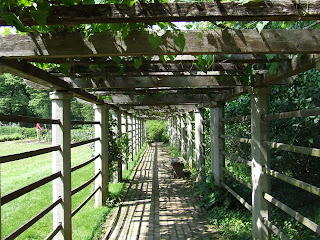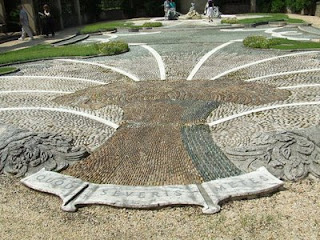
A title like that is just so luscious. And it delivers.
GASLIGHT GRIMOIRE, edited by J. R. Campbell and Charles Prepolec, is a very fun anthology of Sherlock Holmes pastiches, largely with a supernatural or fantastic bent, and overall (barring a couple of false notes) well-written. While most of them refer at some point to the Doyle canon, for the most part they appear to inhabit their own little universes, each one a different take on a fantastic adventure of Holmes. And, with one exception, they avoid the radical revisionism of Holmes that I find annoying and distasteful (yes, Laurie King, I'm looking at you).
There are two stories by big-name authors, Barbara Hambly and Kim Newman, and then there are names I recognize from my perambulations here and there in the genre world, like Chico Kidd (whose PRINTERS DEVIL I read long ago and enjoyed), Barbara Roden of the Ash-Tree Press, and Holmes expert David Stuart Davies, who contributed a forward. But that's not to say this is amateur-hour stuff; there's not a single story in here that struck me as first-timer fanfic. Standards are high here, and I appreciated that.
So, to give a rundown...
"The Lost Boy" by Barbara Hambly, which opens the collection, is a beguiling tale that crosses Holmes with J. M. Barrie's Peter Pan, only with real menace. It's also unusual for being told from the point of view of Watson's wife (or one of them, I lose track). Despite the potential for cloying whimsy (and if there's one thing I can't stand, it's cloying whimsy), Hambly gives it a good measure of darkness and real emotion.
The next story, "His Last Arrow" by Christopher Sequeira, is the one I liked the least in the collection. It was certainly well-written enough, and certainly had imagination to spare, but his approach to Holmes and Watson was one that I simply did not like. I'm not saying it's a bad story...far from it....but I just found this story's version of the Holmes canon to be not to my taste.
Barbara Roden's "The Things That Shall Come Upon Them," is roaring good fun for someone of my literary tastes. Holmes and Watson team up with occult investigator Flaxman Low (a creation of Kate & Hesketh Prichard) and investigate the former home of Julian Karswell (the villain of M. R. James' classic short story "Casting the Runes"). Roden knows her subject and has fun with it, and the story is a great ride.
"The Finishing Stroke" by M. J. Elliott is a fun bit of mystery/horror as Holmes goes on the track of paintings that appear to come to life, with the expected deadly results. "Sherlock Holmes in the Lost World" isn't supernatural, but a steampunk fantasia in which Holmes meets up with another Doyle creation, Prof. Challenger, in the infamous Lost World in South America.
Chico Kidd and Rick Kennett had fun with "The Grantchester Grimoire," which features another crossover, this time with Holmes teaming up with William Hope Hodgson's occult detective Thomas Carnacki. Kidd & Kennett know their Carnacki and keep him true to Hodgson while keeping Holmes credible. It's another fun romp.
"The Steamship Friesland," by Peter Calamai, didn't grab me as much as some of the others. It's a valiant attempt at building a supernatural tale around one of Holmes' unsolved cases (a ship that passes into a fogbank only to disappear; it's mentioned in one of the stories), but Holmes suddenly developing mediumistic abilities didn't sit well with me. (OK, OK, so I'm a stickler...) J. R. Campbell's "The Entwined" feels oddly incomplete, but tantalizingly so, with members of a secret brotherhood being killed off by an otherworldly being. It's not a bad story at all, but after reading it there was a sense of something just outside my grasp that left me wanting more information.
"Merridew of the Abominable Memory," by Chris Roberson, sticks out a little for having no fantastic content. However, it is memorably gruesome, with a plausible plot, and actually a bit of an emotional whallop at the end.
Bob Madison's "Red Sunset" gives us an elderly Holmes residing in Los Angeles and summoned by a policeman to investigate a strange crime. Not bad in and of itself, but it's basically set up as a final confrontation between Holmes and an old enemy, and getting some background on it would have made it better.
The final story, "The Red Planet League" by Kim Newman, is the best. Holmes doesn't even appear in it. Instead, it's narrated by Col. Sebastian Moran (and sounding rather Flashmanesque), playing a sort of anti-Watson to Prof. Moriarty's anti-Holmes. It's a delicious tale of Moriarty being insulted by an arrogant young upstart astronomer, and the resulting revenge involving...well, I won't say, but you can take a few cues from the title. The plot borrows cues from at least two H. G. Wells works, and even a bit from Heinlein. Again, this is steampunk rather than supernatural, but it's great fun and a wonderful capper to the book.
So was it worth it? Oh yeah, even with the missteps it's still a fun read and worth getting for fans of Holmes and horror fiction. Look for it. And I hear rumors of a sequel collection in the works....







































